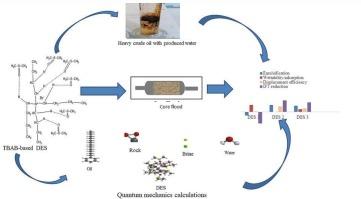通过实验和计算分析,阐明了重质原油深层共晶溶剂的回收及机理
IF 5.2
2区 化学
Q2 CHEMISTRY, PHYSICAL
引用次数: 0
摘要
为了提高采收率,对绿色溶剂的追求导致了深共晶溶剂(DESs)的使用,该溶剂可以在各种油藏条件下有效工作。迄今为止,最常报道的用于提高采收率的DESs评估是基于氯化胆碱的DESs。然而,人们发现,这些DESs往往面临着无法充分降低稠油油藏界面张力的挑战。因此,本研究探讨了四丁基溴化铵(TBAB)与聚乙二醇400 (PEG 400)、TBAB/二甲基亚砜(DMSO)和TBAB/N, N-二甲基甲酰胺(DMF)分别合成DES-1、DES-2和DES-3。DESs用于研究DES/水混合物与重质原油之间界面张力(IFT)的降低,以及地层损害、吸胀和岩心驱油结果。从IFT减少的结果来看,DES-1、DES-2和DES-3分别减少了67.4%、85.7%和83.3%的IFT。从岩心驱替结果来看,采用DES-1、DES-2和DES-3驱替的总驱替效率分别为76.92%、98.39%和89.79%。随后,在Spartan分子建模包中使用PM3进行量子力学计算,以增强实验分析,并进一步了解DES与油、盐水与油、DES与岩石基质以及油与岩石基质之间相互作用的机制。结果表明,对DES-1油藏而言,润湿性改变和低流度比是其采油的最重要机制。DES-2基本上采用了IFT降低和流动性控制相结合的方法来采油。而乳化、波及效率和润湿性改变对DES-3提高采收率(EOR)有重要影响。相比之下,氯胆碱基DES将重质原油的IFT从6.4 mN/m提高到11.4 mN/m,最高可达21.9 mN/m。这证明了基于tbab的DESs在降低稠油油藏的IFT和含水率方面的有效性,从而提高了原油采收率。本文章由计算机程序翻译,如有差异,请以英文原文为准。

Elucidating recovery and mechanism of deep eutectic solvents for heavy crude oil via experimental and computational analysis
The quest for green solvents for enhanced oil recovery resulted in the use of Deep Eutectic Solvents (DESs), which can work effectively in a range of reservoir conditions. The most often reported DESs evaluated for enhanced oil recovery to date are those based on choline chloride. Nevertheless, it has been found that these DESs often come with challenges like inability to sufficiently reduce the interfacial tension of heavy crude oil reservoir. Therefore, in this study, tetrabutylammonium bromide, (TBAB) with polyethylene glycol 400 (PEG 400), TBAB/dimethyl sulfoxide (DMSO) and TBAB/N, N-dimethyl formamid (DMF) were explored to synthesize DES-1, DES-2 and DES-3 respectively. The DESs were used to investigate the reduction of interfacial tension (IFT) between the DES/water mixture and heavy crude oil, as well as formation damage, imbibition and core flooding results. From the IFT reduction findings, DES-1, DES-2 and DES-3 reduced the IFT by 67.4 %, 85.7 % and 83.3 % by respectively. From the core flooding result, a total displacement efficiency of 76.92 %, 98.39 % and 89.79 % were obtained using DES-1, DES-2 and DES-3 respectively. Afterward, quantum mechanics calculations using PM3, semi-empirical were performed in the Spartan molecular modeling package to augment the experimental analysis and also gain more insight on the mechanisms underlying the interactions between the DES and oil, brine and oil, DES and the rock matrix, as well as between the oil and the rock matrix. The findings revealed that for DES-1, wettability alteration and low mobility ratio are the most vital mechanism for its oil recovery. DES-2 essentially employed IFT reduction combined with mobility control to recover oil. While emulsification, sweep efficiency and wettability alteration contributed significantly to DES-3 for Enhanced Oil Recovery (EOR). In contrast, choline chloride-based DES increased IFT from 6.4 to 11.4 mN/m and up to 21.9 mN/m in heavy crude oils. This attests to the improved efficacy of TBAB-based DESs in lowering IFT and water cut in heavy oil reservoirs, which increases oil recovery.
求助全文
通过发布文献求助,成功后即可免费获取论文全文。
去求助
来源期刊

Journal of Molecular Liquids
化学-物理:原子、分子和化学物理
CiteScore
10.30
自引率
16.70%
发文量
2597
审稿时长
78 days
期刊介绍:
The journal includes papers in the following areas:
– Simple organic liquids and mixtures
– Ionic liquids
– Surfactant solutions (including micelles and vesicles) and liquid interfaces
– Colloidal solutions and nanoparticles
– Thermotropic and lyotropic liquid crystals
– Ferrofluids
– Water, aqueous solutions and other hydrogen-bonded liquids
– Lubricants, polymer solutions and melts
– Molten metals and salts
– Phase transitions and critical phenomena in liquids and confined fluids
– Self assembly in complex liquids.– Biomolecules in solution
The emphasis is on the molecular (or microscopic) understanding of particular liquids or liquid systems, especially concerning structure, dynamics and intermolecular forces. The experimental techniques used may include:
– Conventional spectroscopy (mid-IR and far-IR, Raman, NMR, etc.)
– Non-linear optics and time resolved spectroscopy (psec, fsec, asec, ISRS, etc.)
– Light scattering (Rayleigh, Brillouin, PCS, etc.)
– Dielectric relaxation
– X-ray and neutron scattering and diffraction.
Experimental studies, computer simulations (MD or MC) and analytical theory will be considered for publication; papers just reporting experimental results that do not contribute to the understanding of the fundamentals of molecular and ionic liquids will not be accepted. Only papers of a non-routine nature and advancing the field will be considered for publication.
 求助内容:
求助内容: 应助结果提醒方式:
应助结果提醒方式:


